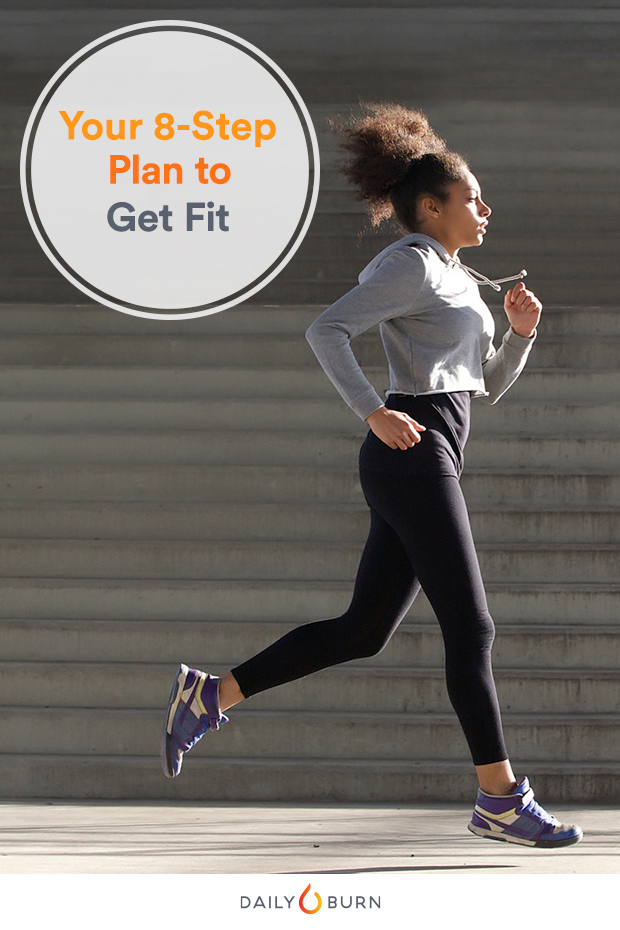
You’ve committed to losing the weight, now where the heck do you begin? Do you have to live in the gym? Become as bendy as a hard-core yogi? Start running and see how far you can make it? No, no and no. (Whew. That sounds awful.) When you have a lot of weight to lose, choosing a healthy lifestyle is the first step. And while you can’t out-exercise a bad diet, making fitness a part of your regular routine is always a good idea.
So what now? While everyone should be careful when starting a new workout routine, as a newbie you should be sure to get the OK from your doc first — especially if you have conditions like high blood pressure or diabetes. Now that we’ve got that business out of the way, it’s time to get to work. We asked two personal trainers and weight loss experts about how they help their clients find success.
RELATED: Daily Burn 365: New Workouts, 7 Days a Week
8 Expert-Approved Steps to a Fitter You
Step 1: Make today the day.
No need to wait until Monday, the beginning of the month — or even tomorrow. “The best day to start an effort to become more healthy and fit is always today. Once you have started, you have dramatically increased your ability to become healthy,” says Lee Jordan, American Council on Exercise certified health coach, personal trainer and ACE Spokesperson.
Step 2: Ask yourself: What do you like?
That’s so important when starting any program, says Kelly Drew, MS, an American College of Sports Medicine-registered clinical exercise physiologist. Maybe you enjoy power walking around your neighborhood or you’ve always wanted to try an on-demand dance video in your living room. “People are only successful if they’re doing something they enjoy,” he says. Drew tends to recommend lower impact workouts — biking, walking — for newbies because these help prevent injuries (and getting hurt puts a quick stop on your plans).
RELATED: 3 MMA Moves Even YOU Can Do
“Rather than do 40 minutes two days a week, you’re better off doing 13 minutes a day for six days.”
Step 3: Figure out when can you do it.
Luckily, getting fit isn’t all or nothing. No one says you have to dedicate an hour to it every day, either. In fact, you only need 10 to 15 minutes, says Drew. “Most people wait until they have time to exercise, and that will never happen,” he says. So take a look at your schedule and see what jives with your lifestyle the best. Is it a 15-minute break at lunch? Or right when you get up? (Hello, Daily Burn 365!) Anytime is a good time. Start with 10 to 20 minutes, three days a week, and work your way up from there, he advises.
Step 4: Be consistent.
“Frequency is what helps the exercise habit stick,” says Jordan. When you’re active one day, and the next, and the next (you get the idea), you become someone who naturally moves their body every day. After you’ve ramped up your activity level slowly, you should aim to do some type of exercise six days a week. Again, that doesn’t mean busting your butt for hours a day — go big or go home does not apply — and can lead to injury. “Rather than do 40 minutes two days a week, you’re better off doing 13 minutes a day for six days,” he says. This will hardwire the habit in a way that will stick.
RELATED: What Happens to Your Body When You Skip the Gym
Step 5: Keep your mojo going.
Set a goal, says Drew. Otherwise, if your main purpose is to just “lose weight,” you can lose motivation fast, he says. His clients might train to walk a mile or a 5K or do one full push-up, for example.
Step 6: Don’t be afraid to modify.
No one expects you to do a perfect burpee or hop into downward dog on your first try. If you’re doing a few yoga poses at home, go ahead and rest in child’s pose for as long as you need. Many gyms offer newbies a complimentary personal training session where you can get tips for moves that will be safe for you. And you can always ask questions of any trainer who’s mulling around the gym floor — from what speed you should put the stair stepper on to how to do a bicep curl with the right form.
RELATED: Got Wrist Pain? 6 Modifications That Can Help
Step 7: Think differently.
Another problem with exercising to lose weight is that it can start to become dread-worthy. (Ugh, 6 a.m. alarm for the gym…again?) Instead, say this to yourself, and repeat it often: I choose to exercise because it makes me feel good. (Want more? These 17 positive affirmations will change the way you think.) “It can be difficult to do, but once you frame [exercise] as a reward instead of a punishment, everything else becomes easier,” says Drew.
RELATED: 11 Non-Scale Victories So Much Better Than Weight Loss
Step 8: Just do it.
Instead of debating whether you should exercise, then deciding that, yes, you should, and then doing it, Jordan suggests flipping that mentality on its head. “Just do your morning exercise, then debate about if it was a good idea or not, and finally decide if you were happy you did it,” he says. Trust us, you’ll decide that, yep, that was a great idea. Remember this: You never regret a workout.
